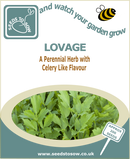Description
Lovage is a perennial herb with many uses, with a celery like taste to the leaves. The roots can also be eaten, but as this is a perennial it is generally grown for its leaves, which make a refreshing tea when dried.
| When to sow | Can be sown under glass from March but best sown direct outdoors from April. |
| Where to sow | Direct sow outside either thinly in rows or sparsely in pots. |
| Plant out well rooted plants into the garden in late spring or early summer. | |
| What to do sext | Plant in rich, deep, moist soil in sun or partial shade. |
| Harvest | Use the leaves when young and tender, or dry leaves to make tasty herbal teas. Roots can be dug out in Autumn. |
| Handy Tips | Lovage will self seed so weed out any new seedlings to prevent these plants from smothering any others around it. Trim in summer to encourage new shoots. |
| Plants start to die back in autumn. At this time, cut stems back to just above ground level. Plants can then be divided in the spring. |
|
| Companion Planting | Plant with other herbs like parsley, or with other perennial vegetables like asparagus and rhubarb. |
| Nutritional Information | Medicinal note: Teas of the leaf and stalk were common and used for sore throats and tonsil problems, rheumatism/arthritis, jaundice, and for digestion. However you should always check with your doctor before using herbs for medicinal purposes. |
| Serving Suggestion | Young leaves are perfect for adding to salads, soups and stews or as part of a bouquet garni. |
Payment & Security
Your payment information is processed securely. We do not store credit card details nor have access to your credit card information.




